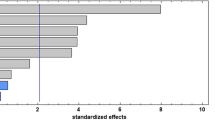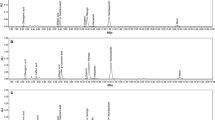Abstract
The present study aimed to extract total phenolic compounds (TPC), total flavonoid compounds (TFC), and ascorbic acid (AA) from the fruit of rugosa rose (Rosa rugosa Thunb.) by ultrasound-assisted extraction (UAE), and to evaluate their antioxidant activities. UAE significantly increased the extract yield compared with that obtained using the conventional method. TPC, TFC, and AA were extracted, depending on the extraction conditions (temperature, time, and ethanol concentration), in the range of 50.73–96.69, 15.93–31.88, and 3.06–6.08 mg/g, respectively. TPC and TFC were effectively extracted at a relatively high temperature (50 °C) than AA was (30 °C). The solvent condition used to extract TPC, TFC, and AA was 50% ethanol. The UAE condition for the highest antioxidant activity was obtained 30 °C, 30 min, and 50% ethanol, which were the same condition for the highest AA extraction. Among the extracts, AA showed a strong correlation with antioxidant activity at p-value of 0.001.



Similar content being viewed by others
References
Jang HR, Park BJ, Park SA, Pee OJ, Park SY, Park KY. Optimization of shoot cultures and bioactive compound accumulation in Rosa rugosa during acclimatization. J. plant Biotechnol. 43: 104–109 (2016)
Demir N, Yildiz O, Alpaslan M, Hayaloglu AA. Evaluation of volatiles, phenolic compounds and antioxidant activities of rose hip (Rosa L.) fruits in Turkey. LWT - Food Sci. Technol. 57: 126–133 (2014)
Hashidoko Y. The phytochemistry of Rosa rugose. Phytochemistry 43: 535–549 (1996)
Razungles A, Oszmianski J, Sapis JC. Determination of Carotenoids in Fruits of Rosa sp. (Rosa Canina and Rosa Rugosa) and of Chokeberry (Aronia Melanocarpa). J. Food Sci. 54: 774–775 (1989)
Czyzowska A, Klewicka E, Pogorzelski E, Nowak A. Polyphenols, vitamin C and antioxidant activity in wines from Rosa canina L. and Rosa rugosa Thunb. J. Food Comp. Anal. 39: 62–68 (2015)
Cabiscol E, Tamarit J, Ros J. Oxidative stress in bacteria and protein damage by reactive oxygen species. Int. Microbiol. 3: 3–8 (2010)
Kang HS, Chung HY, Kim JY, Son BW, Jung HA, Choi JS. Inhibitory phlorotannins from the edible brown alga Ecklonia stolonifera on total reactive oxygen species (ROS) generation. Arch. Pharm. Res. 27: 194–198 (2004)
Hayes JD, Chanas SA, Henderson CJ, McMahon M, Sun C, Moffat GJ, Yamamoto M. The Nrf2 transcription factor contributes both to the basal expression of glutathione S-transferases in mouse liver and to their induction by the chemopreventive synthetic antioxidants, butylated hydroxyanisole and ethoxyquin. Biochem. Soc. Trans. 28: 33–41 (2000)
Vilkhu K, Mawson R, Simon L, Bates D. Applications and opportunities for ultrasound assisted extraction in the food industry - A review. Innov. Food Sci. Emerg. Technol. 9: 161–169 (2008)
Saleh IA, Vinatoru M, Mason TJ, Abdel-Azim NS, Aboutabl EA, Hammouda FM. A possible general mechanism for ultrasound-assisted extraction (UAE) suggested from the results of UAE of chlorogenic acid from Cynara scolymus L. (artichoke) leaves. Ultrason. Sonochem. 31: 330–336 (2016)
Scalbert A, Monties B, Janin G. Tannins in wood: comparison of different estimation methods. J. Agric. Food Chem. 37: 1324–1329 (1989)
Zhishen J, Mengcheng T, Jianming W. The determination of flavonoid contents in mulberry and their scavenging effects on superoxide radicals. Food Chem. 64: 555–559 (1999)
Nováková L, Solich P, Solichová D. HPLC methods for simultaneous determination of ascorbic and dehydroascorbic acids. Trac-Trends Anal. Chem. 27: 942–958 (2008)
Brand-Williams W, Cuvelier ME, Berset CLWT. Use of a free radical method to evaluate antioxidant activity. LWT - Food Sci. Technol. 28: 25–30 (1995)
Re R, Pellegrini N, Proteggente A, Pannanla A, Yang M, Rice-Evans C. Antioxidant activity applying an improved ABTS radical cation decolorization assay. Free Radic. Biol. Med. 26: 1231–1237 (1999)
Ferreira IC, Baptista P, Vilas-Boas M, Barros L. Free-radical scavenging capacity and reducing power of wild edible mushrooms from northeast Portugal: Individual cap and stipe activity. Food Chem. 100: 1511–1516 (2007)
Ma YQ, Chen JC, Liu DH, Ye XQ. Simultaneous extraction of phenolic compounds of citrus peel extracts: effect of ultrasound. Ultrason. Sonochem. 16: 57–62 (2009)
Carrera C, Ruiz-Rodríguez A, Palma M, Barroso CG. Ultrasound assisted extraction of phenolic compounds from grapes. Anal. Chim. Acta. 732: 100–104 (2012)
Suslick KS, Hammerton DA, Cline RE. Sonochemical hot spot. J. Am. Chem. Soc. 108: 5641–5642 (1986)
Davey MW, Montagu MV, Inzé D, Sanmartin M. Kanellis A, Smirnoff N, Benzie IJJ. Strain JJ, Favell D, Fletcher J. Plant L‐ascorbic acid: chemistry, function, metabolism, bioavailability and effects of processing. J. Sci. Food Agric. 80: 825–860 (2000)
Portenlänger G, Heusinger H. Chemical reactions induced by ultrasound and γ-rays in aqueous solutions of L-ascorbic acid. Carbohydr. Res. 232: 291–301 (1992)
Tiwari BK, OʼDonnell CP, Patras A, Cullen PJ. Anthocyanin and ascorbic acid degradation in sonicated strawberry juice. J. Agri. Food Chem. 56: 10071–10077 (2008)
Cheng VJ, Bekhit AEDA, McConnell M, Mros S, Zhao J. Effect of extraction solvent, waste fraction and grape variety on the antimicrobial and antioxidant activities of extracts from wine residue from cool climate. Food Chem. 134: 474–482 (2012)
Wang J, Sun B, Cao Y, Tian Y, Li X. Optimization of ultrasound-assisted extraction of phenolic compounds from wheat bran. Food Chem. 106: 804–810 (2008)
Mishra K, Ojha H, Chaudhury NK. Estimation of antiradical properties of antioxidants using DPPH assay: A critical review and results. Food Chem. 130: 1036–1043 (2012)
Ramarathnam N, Ochi H, Takeuchi M. Antioxidative defense system in vegetable extracts Natural antioxidants. pp. 76–87. In: Natural Antioxidants: Chemistry, Health Effects, and Applications. Fereidoon S (ed). AOCS press, Champaign, Illinois, USA (1997)
Pinelo M, Arnous A, Meyer AS. Upgrading of grape skins: Significance of plant cell-wall structural components and extraction techniques for phenol release. Trends Food Sci. Technol. 17: 579–590 (2006)
Xu BJ, Chang SKC. A comparative study on phenolic profiles and antioxidant activities of legumes as affected by extraction solvents. J. Food Sci. 72: 159–166 (2007)
Field M, Munafò MR, Franken IH. A meta-analytic investigation of the relationship between attentional bias and subjective craving in substance abuse. Psychol. Bull. 135: 589–607 (2009)
Acknowledgements
This research was supported by Priority Research Centers Program through the National Research Foundation of Korea (NRF) funded by the Ministry of Education, Science and Technology (2010-0020141).
Author information
Authors and Affiliations
Corresponding author
Ethics declarations
Conflict of interest
The authors declare no conflict of interest.
Rights and permissions
About this article
Cite this article
Um, M., Han, TH. & Lee, JW. Ultrasound-assisted extraction and antioxidant activity of phenolic and flavonoid compounds and ascorbic acid from rugosa rose (Rosa rugosa Thunb.) fruit. Food Sci Biotechnol 27, 375–382 (2018). https://doi.org/10.1007/s10068-017-0247-3
Received:
Revised:
Accepted:
Published:
Issue Date:
DOI: https://doi.org/10.1007/s10068-017-0247-3




